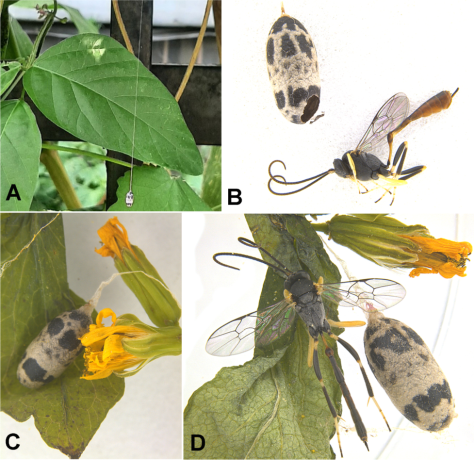Introduction
The subfamily Campopleginae Förster, 1869 is one of the largest subfamilies of Ichneumonidae, It is a big subfamily that comprises one of the two largest ichneumonids of parasitoids of Lepidoptera (Gavin et al., 2018). This subfamily includes approximately 2,100 described species within 66 genera worldwide and; 55 species in 13 genera in South Korea (Yu et al., 2016). At present 61 species in 14 genera from South Korea have been reported (Choi & Lee, 2018; Choi, 2022). The Campopleginae is known as a sister group to Crema-stinae with in a clade of higher ophioniformes (Anomaloninae, Banchinae, Ctenopelmatinae, Mesochorinae, Metopiinae, Nesomesochorinae, Ophioninae, Tersilochinae, Tryphoninae). This subfamily can be distinguished from the Cremastinae by the following characteristics: the pterostigma of Campopleginae is slenderer than that of Cremastinae, whereas the pterostigma of Cremastinae is large and triangular form; the clypeus of Campopleginae is not separated from the face but the clypeus of Cremastinae is distinctly separated from the face; the first metasomal tergite of Campopleginae is petiolated; with posterior transverse carina of the mesosternum completely (Broad et al., 2018).
In this paper, new host plants of Charops striatus from South Korea are reported. Digital images and redescription of this species are provided.
Materials and Methods
Wasps investigated in this study were collected using, sweep net and Malaise traps and deposited in the Insect Inquiry · Education Institute, Daegu National University of Education (DNUE-IIEI, Daegu, South Korea). Morphological terminology followed Gauld (1991) and Broad et al. (2018). Distributional data followed Yu et al. (2016). The collection localities of provinces in South Korea are abbreviated as follows: CN, Chungcheongnam-do; GW, Gangwon-do; JB, Jeollabuk-do; and JJ, Jeju-do.
The specimen was examined using a Leica MC190 HD Camera attached to a Leica M125 Microscope (Leica Microsystems, Germany). Images were processed using LEICA LAS X software (Leica).
Results
Family Ichneumonidae Latreille, 1802
Subfamily Campopleginae Förster, 1869
Genus Charops Holmgren, 1859
Charops Holmgren, 1859. Type species: Campoplex decipiens Gravenhorst = cantator DeGeer. Monobasic.
Zacharops Viereck, 1912. Type species: Charops annulipes Ashmead; synonymized by Townes, 1945.
Gongropelma Enderlein, 1921. Type species: Gongropelma formosanum Enderlein = bicolor Szépligeti; synonymized by Uchida, 1941.
Charops striatus (Uchida, 1932)
Zacharops striatus Uchida, 1932: 133-222. Lectotype: female; Type locarity: Japan; Type depository: Hokkaido University.
Redescription
Body color generally black and reddish brown. Head black; mandible, lablum and palpi yellow. Dorsal part of antennal scape dark brown, ventral part of it yellow. Tegular yellow. Fore leg yellow, apical tarsomeres of fore leg darker; mid leg yellow except coxa black, apical tarsomeres of mid leg darker; hind coxa, femur and tibia black, apical hind femur and basal hind tibia yellow; hind trochanter and trochantellus and tarsi yellow, apical tarsomeres of hind leg darker. Metasomal tergites reddish brown to dark blackish brown, reddish brown in lateral view, dark blackish brown in dorsal view; basal of petiole and postpetiole black.
Head
Head 1.08 times as long as wide; face reticulate rugose, stemmaticum (area bounded by the ocelli) densely reticulate rugose; frons without median longi-tudinal vertical ridge; occipital carina complete. Maximum diameter of lateral ocellus 2.1 times as long as between eye and lateral ocellus, 0.83 times as long as inner length of lateral ocelli. Malar space 0.45 times as long as basal width of mandible. Antenna with 34 flagellomeres; first flagellomere 3.3-3.5 times as long as wide, 1.3-1.4 times as long as second flag-ellomere; scape 3.0 times as long as pedicel in dorsal view.
Mesosoma
Pronotum long and narrow, polished, with distinct epomia; lower area transverse strigose and upper area diagonal strigose; mesoscutum rugose punctate and reticulate rugose, without distinct notaulus. Epicnemial carina distinct; mesopleuron to speculum transverse strigose, behind of epicnemial carina reticulate rugose. Mesoscutellum almost concave or flat in lateral view. Propodeum and metapleuron reticulate rugose; juxtacoxsal carina distinct. Lateromedian longitudinal carina, posterial transverse carina, and lateral longitudinal carina distinct. Fore wing vein 1cu-a postfurcal, without areolet; hind wing nervellus not intercepted. Hind tarsal claw simple.
Metasoma
Petiole slender; tergal-sternal suture of first metasomal segment sigmoid; anterior sclerotized sectionof first metasomal sternite shiny and impunctate. Postpetiole oval and granulate. Glymma absent; thyridium of second metasomal tergite at basal 0.4 of second metasomal tergite. Ovipositor with a dorsal subapical notch.
Specimens examined
3♀♀, at larva of Elcysma westwoodi, 2015, YH Cho; 3♂♂, at larva of Elcysma westwoodi, 2005, YH Cho; 1♀, Yeongjong-do, Incheon-si, 13.vi.1974 YS Ju; 2♀♀, CN, Hanseo Univ., Daegok-ri, Haemi-myeon, Seosan-si, 21.x-30.xi.2006, JW Lee (DNUE-IIEI); 1♀, ditto, 23.ix-9.x.2006 (DNUE-IIEI); 1♀, GW, Mureung valley, Samhwa-dong, Donghae-si (M.T.), 2-10.x.2006, JW Lee (DNUE-IIEI); 2♀♀, ditto, 20.ix-2.x.2006 (DNUE-IIEI); 1♀, ditto, 9.viii.2005 (DNUE-IIEI); 1♀, ditto, 28.viii-10.ix.2006 (DNUE-IIEI); 1♀, JB, Wongwang Univ., Sinyong-dong, Iksan-si, 13-28.x.2005, JW Lee (DNUE-IIEI); 1♀, Bongjeongsa, 4.ix.1998, JW Lee (DNUE-IIEI); 1♀, Bihaksan, Beopgwangsa, 17.viii.1997, JW Lee (DNUE-IIEI); 1♀, Gullyang-ri, 4.vi.1967, JK Oh (DNUE-IIEI); 1♀, JJ, Jeju-si, 31.vii.1967 (DNUE-IIEI).
Host plants
Crepidiastrum denticulatum (new record), Zea mays (new record), Hibiscus syriacus (Choi & Lee, 2008), Prunus yedoensis (Cho et al., 2010) (Fig. 1).
